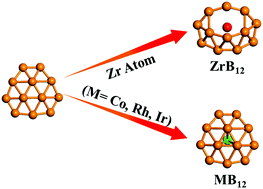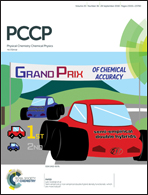Probing the structural and electronic properties of zirconium doped boron clusters: Zr distorted B12 ligand framework†
Abstract
As an extension of boron based materials, transition-metal doped boron clusters deserve interest in controlling size-dependent structural and electronic properties. Herein, using the Crystal structure AnaLYsis by Particle Swarm Optimization (CALYPSO) method and density functional theory (DFT) calculations, we have performed a global search for the lowest-energy structures of ZrBQn (Q = 0, −1) clusters with n = 10–20. The results show that the ground-state structures of the obtained clusters feature a distinctive structural evolution pattern, from half-sandwich bowl to distorted drum-like and then to Zr-centered distorted tubular motifs. For the sake of validating the current ground-state structures, photoelectron spectra are predicted from time-dependent DFT calculations. More interestingly, the neutral and anionic ZrB12 clusters are found to possess enhanced stability in the size regime studied here. The stability of the closed shell half-sandwich ZrB12 cluster is analyzed by intrinsic bond orbital (IBO) and Adaptive Natural Density Partitioning (AdNDP) methods, which indicates that the stability mechanism is caused by the dopant Zr atom breaking the boron bowl's triangle B3 unit to form a quasi-linear B3 unit in B12 and strengthen both the interaction of the B–B σ-bonds and the Zr–B π-bonds.



 Please wait while we load your content...
Please wait while we load your content...